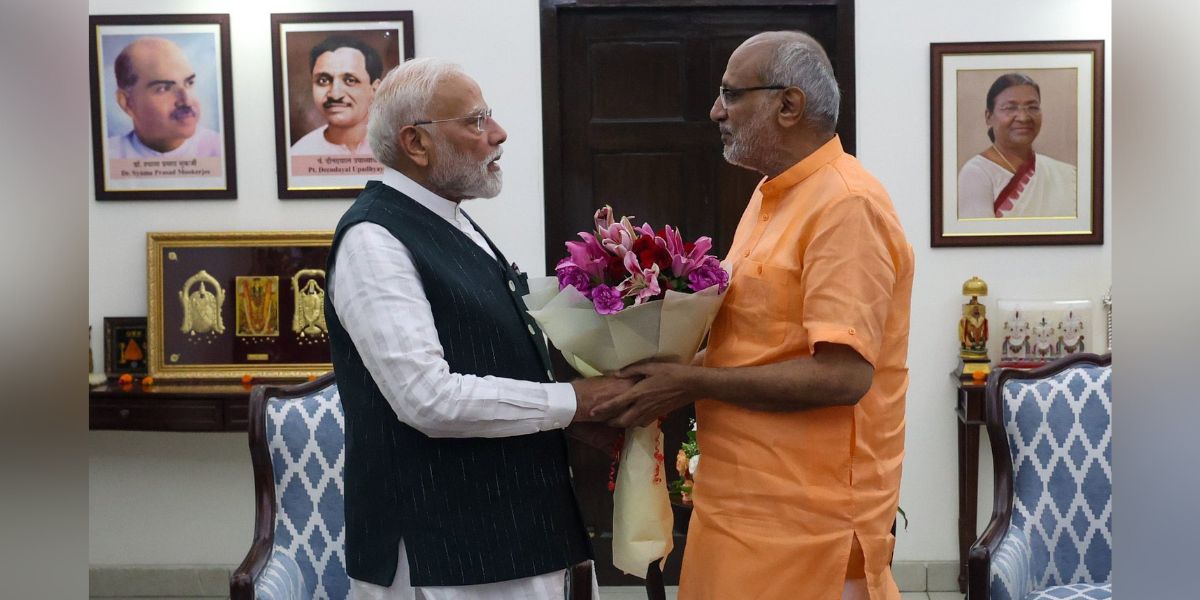As the NDA celebrates its victory, the Opposition must introspect to avoid repeating these missteps in future electoral battles.
Published Sep 10, 2025 | 11:00 AM ⚊ Updated Sep 10, 2025 | 11:00 AM

Vice-President CP Radhakrishnan and Prime Minister Narendra Modi.
Synopsis: The Vice Presidential election laid bare the persistent disunity within the INDIA bloc, highlighting its struggle to challenge the ruling NDA. An examination of the results reveals suspicions of cross-voting and a significant number of invalid ballots from the Opposition’s ranks.
The Vice-Presidential election in India, held on Tuesday, 9 September, has laid bare the persistent disunity within the Opposition INDIA bloc, highlighting its struggle to challenge the ruling NDA.
An examination of the election results reveals a familiar narrative of fragmentation, with suspicions of cross-voting and a significant number of invalid ballots potentially originating from the Opposition’s ranks.
This outcome not only secured a decisive victory for the NDA candidate but also raised critical questions about the Opposition’s ability to coalesce amid ongoing political unrest.
The electoral college for the Vice-Presidential poll consisted of 781 members from both Houses of Parliament, including 543 from the Lok Sabha and 238 from the Rajya Sabha, adjusted for some vacancies. The election saw a high turnout of 98.2 percent, with 767 MPs casting their ballots.
However, 15 votes were deemed invalid, leaving 752 valid votes in the final count. NDA nominee CP Radhakrishnan, the Governor of Maharashtra and a veteran BJP leader with Rashtriya Swayamsevak Sangh (RSS) roots, secured 452 votes, while the INDIA bloc’s candidate, retired Supreme Court judge B Sudershan Reddy, garnered only 300.
This gave Radhakrishnan a commanding victory margin of 152 votes, cementing his position as India’s 15th Vice-President.
These numbers reveal a deeper issue when viewed against the Opposition’s expectations. A senior Congress leader had projected a “100 percent turnout” from the INDIA bloc, estimating their candidate would secure at least 315 votes based on the alliance’s combined parliamentary strength.
The actual tally of 300 votes — a shortfall of 15 — aligns suspiciously with the number of invalid ballots. This has sparked speculation that either some INDIA bloc MPs cross-voted for the NDA candidate or the invalid votes largely came from Opposition members, possibly due to procedural errors, intentional sabotage, or internal dissent.
Cross-voting has repeatedly undermined India’s Opposition alliances, and this election appears no different. The INDIA bloc, comprising parties like Congress, Trinamool Congress, Samajwadi Party, and others, commands around 315 MPs across both Houses, including allies and sympathetic independents. Yet, the results suggest at least 15 votes went astray.
Analysts point to underlying tensions: Regional rivalries and ideological differences within the bloc often lead to fractured voting. For instance, the Trinamool Congress, led by Mamata Banerjee, has occasionally distanced itself from the Congress-led alliance, and some of its MPs may have abstained or voted strategically.
Similarly, smaller parties or individual lawmakers, facing local pressures from the BJP, might have cross-voted to protect their interests — a pattern seen in past elections.
The 15 invalid votes add further complexity. In the Vice-Presidential election, governed by a secret ballot and single transferable vote system, invalidations typically result from marking errors, such as incorrect preferences or defaced ballots. However, the exact match between the Opposition’s vote shortfall and the invalid ballots raises questions.
Some Opposition leaders privately admit that disgruntled members, unhappy with candidate selection or internal leadership disputes, might have deliberately cast invalid votes as a form of protest.
This mirrors the 2022 Vice-Presidential election, where the NDA’s Jagdeep Dhankhar won with 528 votes against opposition candidate Margaret Alva’s 182, amid 15 invalid votes and clear cross-voting from non-BJP parties. Alva’s tally fell well short of the expected 200-plus votes, reflecting similar defections.
The INDIA bloc’s ongoing unrest reflects broader challenges. Formed in 2023 to counter the NDA’s dominance, the alliance struggles to unify due to ego clashes among leaders like Rahul Gandhi, Akhilesh Yadav, and Arvind Kejriwal.
The Vice-Presidential poll, though ceremonial, serves as a litmus test for unity ahead of key state elections and the 2029 general polls. The Opposition’s shortfall could embolden the NDA, which showcased remarkable discipline in mobilising its 437-odd MPs (plus allies) to deliver 452 votes, possibly gaining from Opposition defectors.
In conclusion, the 2025 Vice-Presidential election, with 452 votes for Radhakrishnan, 300 for Reddy, 15 invalids, and a 152-vote margin, underscores the INDIA bloc’s persistent disunity.
Cross-voting and potential self-sabotage continue to weaken its ambitions. Without addressing internal divisions through better coordination, trust-building, and strategic candidate choices, the alliance risks remaining a fragmented coalition rather than a formidable force.
As the NDA celebrates its victory, the Opposition must introspect to avoid repeating these missteps in future electoral battles.
(Views are personal. Edited by Muhammed Fazil.)
